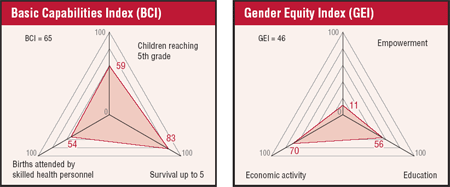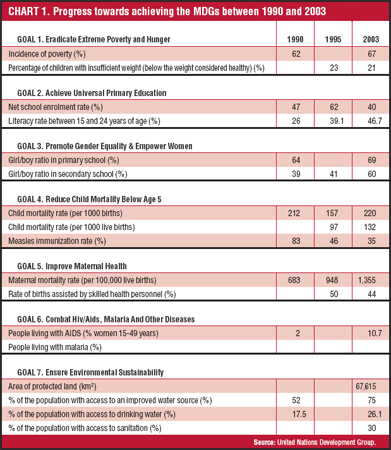The reduction of poverty: a very distant objective
The reduction of poverty: a very distant objective
GAPAFOT
Pastor Clotaire Rodonne Siribi
Instead of diminishing, poverty has increased significantly in the Central African Republic since 1990. The disturbances, looting and destruction that accompanied the rebellion that placed General François Bozizé in the presidency ruined the already weak economy. While the Government is proposing a strategy for poverty reduction, it is unlikely that this will succeed in reducing poverty in half unless the country is able to chart an immediate and lasting change of direction towards peace and security, accompanied by an exceptionally high level of growth benefitting the poor.
 |
Despite its many resources, the economy of the Central African Republic has been sabotaged by years of plundering of public funds and recurring political and military crises. The rebellion of 15 March 2003 that placed General François Bozizé in the presidency was accompanied by disturbances, looting and destruction. This shredded an economic fabric already ripped apart by more than 20 years of gangster-like rule that emptied state coffers and devastated production.
A large part of the republic’s 623,000 km2 is covered in forests; its soil is rich in diamonds. However this natural wealth– the country’s principal source of income – has long been exploited to fill the pockets of whoever happens to be in power and his cronies. Even though the soil is fertile – only a fifth of it is cultivated – and the climate favourable, cotton and coffee production have steadily declined in recent years. The 2004-2005 cotton harvest was 5,000 tonnes, down from 50,000 in 1998. This is partly a result of erratic support, but primarily due to a system of international commerce that tips the scales against African producers – most heavily by permitting industrialized countries to subsidize their producers. In the past, the country harvested more than 18,000 tonnes of coffee annually, but the crop has virtually disappeared. Agriculture in general is in ruins. The country’s farmers, who were devastated during the rebellion, are living in a state of chronic insecurity and barely able to continue harvesting subsistence crops.
The steady decline in production has decimated income from taxes and customs tariffs, already limited by inefficient tax collection – a problem regularly cited by the IMF, which granted the country a USD 8.2 million loan in July 2004 to support a post-conflict rehabilitation programme. While revenues are down, the country still has to make payments on a crushing foreign debt, which had reached more than USD 1 billion by the end of 2002. Servicing it devoured 44.7% of the budget in 2003, according to the Bank of the Central African States (BEAC).
The State’s incapacity
All foreign aid has been suspended since an attempted coup d’état in May 2001. The country has only been able to keep its head above water thanks to donations in 2004 from the country’s traditional partners – the European Union, France, China and the Central African Economic and Monetary Community. The State appears to be incapable of paying salaries to its civil servants, let alone pensions and grants. When President Ange Patassé was deposed in March 2003, government employees were owed 36 months’ salary. When his successor, François Bozizé, wiped the slate clean, he made a commitment to pay salaries on time. The Ministry of Economy soon admitted that this was impossible; civil servants received their July 2004 salaries in January 2008. These delays have reduced domestic consumption and generated social tension, which has been exacerbated by high inflation, particularly in food prices. Despite these difficulties, the economy inched ahead 2.5% in 2004 after several years of stagnation.
For Central Africans, the Millennium Development Goals (MDGs) will continue to be a distant dream. According to the United Nations Development Programme (UNDP), two thirds of the population (3.8 million people) subsist below the poverty level. Life expectancy is 39.5; more than one child in ten (11.5%) dies before the age of five. Less than half the adult population (48.6%) is literate. These statistics place the Central African Republic in 169th place amongst the 177 countries classified in the Human Development Index.
In the course of a decade in which life expectancy at birth dropped by six months each year and the country experienced one of the highest HIV/AIDS rates in the region, official development assistance plunged 80%.
 |
A strategy for poverty reduction
To ameliorate this disastrous situation, the Government is attempting to implement a Poverty Reduction Strategy (PRS) with two major goals:
1. Creating wealth by strengthening human and institutional capabilities within the productive system, including those of the poorest inhabitants, through good governance and the reestablishment of security.
2. Improving and expanding basic social services through a participatory approach to implementation and control/evaluation of the country’s Poverty Reduction Strategy.
The strategy has four main objectives:
a. Restoration of security, consolidation of peace and prevention of conflict. The reforms this will require include reinforcement of the material and human capabilities of the Social Development Fund (SDF) as well as reform, restructuring, territorial reorganization and participatory and coordinated transformation of the security sector.
b. Promotion of good governance and the rule of law through reforms that include reinforcing political and judicial governance, improving economic governance, improving local governance and gender participation and promotion.
c. Reconstruction and diversification of the economy through macroeconomic stabilisation, rural development, transparent and effective administration of natural resources, promotion of tourism and crafts, and development of infrastructure that supports production.
d. Development of human capital through reforms that include expansion of education, particularly primary and secondary schools; accessibility to health services; the fight against HIV/AIDS; and measures to generate employment.
Analysing poverty
The current analysis of poverty in the Central African Republic is based on two studies conducted by the Ministry of Planning on living conditions in urban and rural settings. They were carried out in 2003 with technical and financial support from the UNDP, and supplemented in 2006 with a participatory research study financed by the World Bank.
These studies identified 10 major problems: bad governance, insecurity, low income, inefficient education and training, poor health, corruption, lack of employment and the absence of opportunities, lack of drinking water, the absence of a policy for strengthening of national capabilities and environmental issues. Amongst these 10, group or individual statements of participants in every region singled out three as most pressing: poor governance, insecurity and lack of peace.
Poor conditions are prevalent throughout the country. Some neighbourhoods of Bangui, the capital city, have electricity only four days out of seven; most neighbourhoods have no access to drinking water. Faced with a sharp drop in income, many Central Africans are invading green space in cities and forested areas. With inflation rapidly eroding already meagre incomes, selling wood for fuel is often the only alternative to the more precarious, badly-paid and illicit ways of earning an income that have also proliferated. As a result, the savannah is advancing at a rate of nearly 500 meters a year on each side of the Bangui-Boal axis; it has already moved almost 30 kilometers toward the south and southwest.
Overall, the poverty rate is 73% in cities and 69% in rural areas. This deprivation is heightened by huge disparities in income and domestic expenses. The consumption level of the poorest 10% of households is barely one-tenth that of the wealthiest 10%. It is highly unlikely that the objective of reducing poverty to 31% by 2015 will be attained unless the country achieves a rapid and lasting return to peace and security throughout its territory, as well as an exceptionally high level of growth that benefits the poor, particularly in rural areas.
| Attachment | Size |
|---|---|
| centralafricanrepublic2009_eng.pdf | 249.25 KB |